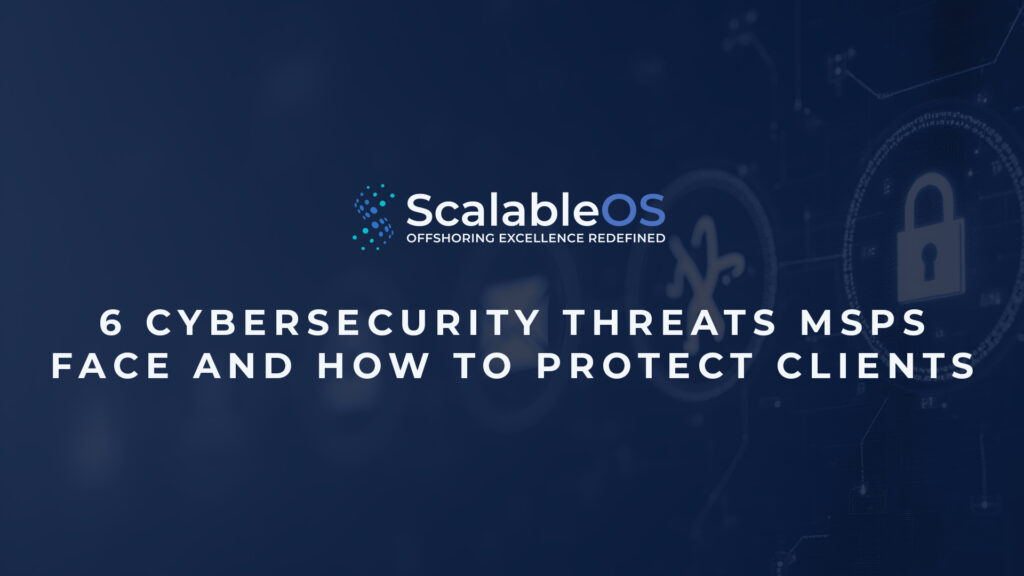Cybercriminals target more than just data—they’re coming for you.
As a managed service provider, you’re supporting IT and entire business ecosystems. That’s why MSP cybersecurity is mission-critical. A single breach can compromise your operations, but more than that, it can give attackers a backdoor into every client system you serve.
Today’s threat landscape is more aggressive than ever. With the rise of ransomware-as-a-service, advanced phishing schemes, and deep supply chain intrusions on the rise, cybersecurity managed service providers have become high-value targets in the digital underground.
The fallout from one attack? Client downtime, exposed data, compliance violations, and damage to your hard-earned reputation.
Indeed, cybersecurity managed services can’t be an afterthought. As you carry the dual responsibility of ensuring top-tier service delivery and airtight security, strategies like zero-trust architectures, AI-powered threat detection, and MSSP partnerships are essential not just for defense but also for client assurance.
This article breaks down the threats that MSPs face and how to stay ahead of them.
Why MSPs Are Prime Targets for Cybercriminals?
MSPs are prime targets because compromising MSP systems grants hackers access to multiple client environments at once. As a managed cybersecurity service provider, your broad administrative privileges multiply the impact of a single breach.
In fact, 76% of MSPs detected cyberattacks in the past year, and 69% suffered multiple breaches, underscoring attackers’ growing focus on MSP infrastructure.
The stakes are especially high in fast-growing digital economies like Southeast Asia. Thankfully, outsourcing providers in the Philippines play a critical role in supporting global clients, many of whom lack internal cybersecurity teams. This places more responsibility on MSPs like you to provide a strong line of defense.
With your level of access and scale, even one gap can put multiple clients at risk. Prioritizing layered, proactive security is key to staying ahead of threats.
What are the Top 6 Cybersecurity Threats MSPs Face?
MSPs must navigate a growing list of aggressive, sophisticated, and highly coordinated cyberattacks. As an MSP security leader, your exposure is amplified, not only by your own infrastructure but by the vast network of clients, vendors, and tools you support. Below are the most pressing cybersecurity threats facing MSPs in 2025 and the real-world risks they bring.
1. Ransomware-as-a-Service (RaaS)
Ransomware continues to dominate the threat landscape, but today’s attacks are no longer reserved for elite hackers. Ransomware-as-a-service allows low-skilled cybercriminals to rent sophisticated tools and target MSPs as gateways to larger paydays.
By infiltrating your network—often through remote access vulnerabilities or unpatched systems—attackers can deploy ransomware across multiple client environments at once, encrypting data and halting operations. Recovery is about rebuilding trust, managing compliance fallout, and rebuilding client trust.
2. Phishing and social engineering
MSP staff are increasingly targeted through highly tailored phishing emails, voice phishing (vishing), and even fake login pages. These attacks aim to mislead employees into revealing login credentials or downloading malware.
Some campaigns even impersonate client communications to bypass trust barriers. A single successful phishing can lead to credential theft, backdoor access, or remote malware installation across systems you manage. For MSPs who outsource IT services, multiple distributed endpoints reduce visibility and increase risk.
3. Supply chain compromise
If you rely heavily on third-party tools, including RMMs, PSA software, ticketing systems, and monitoring solutions, you may be vulnerable to supply chain attacks. Adversaries target these trusted tools to inject malicious code or steal credentials.
The infamous SolarWinds breach underscored how attackers don’t always break in; they log in through trusted integrations. Supply chain compromise poses a massive risk of undetected, long-term infiltration.
4. Credential theft and privilege escalation
Admin credentials are gold to cybercriminals. Whether acquired via brute force, phishing, or keylogging malware, these credentials allow attackers to move laterally, escalate privileges, and access sensitive client environments. Without multi-factor authentication and strong identity management, a single compromised account can cascade into a full-blown security incident.
5. DDoS attacks on service availability
Distributed denial-of-service (DDoS) attacks targeting MSPs take down access to client-facing systems, cloud services, or even customer portals. These attacks overwhelm bandwidth, degrade system performance, and erode client confidence. As many MSPs evolve into managed security service provider roles, maintaining service availability becomes critical, and a DDoS attack can ruin that promise in minutes.
6. Insider threats
Not all threats come from the outside. Whether it’s a careless technician reusing weak passwords or a disgruntled employee deliberately exfiltrating data, insider threats remain a serious concern. MSPs must account for both accidental misconfigurations and intentional sabotage, especially as teams grow or include contract-based remote staff.
How These Threats Impact MSPs and Clients?
A single breach can ripple across your entire client base. In today’s threat landscape, the consequences of compromised MSP security go far beyond IT.
- Service disruptions and operational downtime
Cyberattacks like ransomware or DDoS can harm client networks, stall productivity, and lead to missed SLAs.
- Loss of client trust and business continuity issues
A breach challenges your core promise of reliability. Clients may terminate contracts or pursue legal action if data is exposed or services fail.
- Regulatory and compliance penalties
Under frameworks like the GDPR, HIPAA, or the Philippines’ Data Privacy Act (DPA), MSPs are required to demonstrate due diligence. Violations can trigger investigations, fines, and disclosure obligations.
- Long-term damage to brand reputation
Publicized security failures hurt more than finances—they erode your credibility with prospects, partners, and investors, limiting future growth.
- Strain on internal teams and resources
Breach response, forensics, and remediation can drain technical teams and take focus away from service delivery and innovation.
To minimize risk and reassure clients, many providers now partner with MSSP cybersecurity experts to enhance their defenses. The business impact of a breach is real and lasting—prevention must be proactive.
What are the Proactive Cybersecurity Measures for MSPs?
In 2025’s high-stakes cyber landscape, prevention is imperative. MSPs need a layered, adaptive defense strategy that combines technology, processes, and people. Here’s a framework of proactive measures you can implement to strengthen your security posture and build lasting client trust.
- Implement a zero-trust architecture
Adopt a “never trust, always verify” model. Zero-trust uses least-privilege access, micro-segmentation, and continuous authentication to block lateral movement, even if an attacker breaches one layer.
- Adopt endpoint detection and response (EDR)
EDR tools continuously monitor endpoints for suspicious behavior. Using AI-driven analytics, they detect anomalies like privilege escalation or command-and-control activity before they escalate into full-scale breaches.
- Conduct regular penetration testing
Schedule quarterly or biannual pen tests and red team exercises to simulate real-world attacks. Combine these with continuous vulnerability scanning to identify and address risks before they’re exploited.
- Invest in employee security training
Human error remains a leading cause of breaches. Regular phishing simulations, incident response drills, and security awareness training empower teams to recognize and respond to social engineering threats.
- Use secure access tools like PAM
Privileged access management (PAM) systems grant temporary, monitored access to critical infrastructure. This limits exposure, prevents over-privileged accounts, and keeps detailed logs for forensic auditing.
- Establish clear cybersecurity SLAs with clients
Define who’s responsible for what in your service contracts. Include response times, breach notification protocols, and data handling policies to align client expectations with your security capabilities.
Partnering with experts in managed security services can help MSPs scale these defenses, strengthening both internal resilience and client assurance.
How to Turn Cybersecurity Into a Competitive Edge?
Your role as an MSP places you at the frontline of your clients’ security. With growing threats and expanding responsibilities, how you protect your infrastructure directly impacts every business you support. That’s why cybersecurity is a core part of service delivery and long-term client trust.
From ransomware and phishing to supply chain attacks, the risks are real—but so are the tools, strategies, and partnerships that can help you stay ahead. A proactive, well-communicated security posture reduces exposure and sets you apart in a crowded market.
At ScalableOS, we help MSPs reinforce cybersecurity posture through skilled teams, purpose-built tools, and proven processes. Learn more about how we support secure, efficient operations on our services page.
Ready to strengthen your defenses? Book your risk assessment now.

Chris Van Vladricken
Chris is the CEO and Co-Founder of ScalableOS, with over 18 years of experience in both Philippines offshoring and Information Technology. A longtime member of EO Seattle, he’s passionate about building high-impact teams that help businesses grow while creating meaningful opportunities in the Philippines. His people-first approach drives the company’s mission to deliver tailored, strategic offshoring solutions that help businesses scale smarter.


